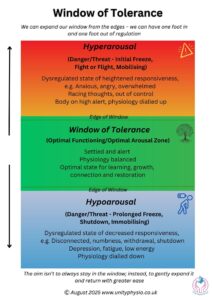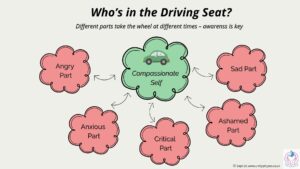What is The Window of Tolerance
The Window of Tolerance is a model of nervous system regulation developed by Dr. Dan Siegel. It describes the optimal zone of arousal – the state where our physiology is balanced, we feel settled enough to connect with others, we can explore, learn and grow. Inside the window emotions and challenges are tolerable, and we can respond rather than react – we can cope with life stressors.
Either side of the window are two dysregulated states — hyperarousal and hypoarousal.
- Hyperarousal is the fight or flight response, driven by the sympathetic nervous system. Here we may feel, for example, anxious or agitated, or on high alert – our physiology is dialled up
- Hypoarousal happens when something is too much for too long, it’s the parasympathetic nervous system without the “vagal brake”, and we lack the enough mobilisation of the sympathetic nervous system that we need to function effectively day to day (this is not the same as the fight or flight response which of course we need too!).
Each of the three zones is associated with different emotions, thoughts, feelings, behaviours and physiology. The window isn’t only about our emotions, it’s about the body and behaviour too – it’s about the whole person and being able to function in a balanced, or efficient, way aS much as possible.
The aim isn’t to stay in our window all of the time – that’s not realistic. Instead, we can over time learn to spend more time there, gently expand the window and recognise its edges (a place of growth). These edges are sometimes called our stretch zone: where we are challenged but not overwhelmed. I’ve created an infographic below which illustrates these states.
(You’re welcome to use & share this infographic – please keep the copyright & logo visible so the work is credited)
What is Nervous System Regulation
Nervous system regulation is a term used to refer to the state of the autonomic nervous system (ANS). The ANS controls bodily functions like heart rate, breathing, digestion and our stress responses, and of these, the breath is unique because can also influence it consciously.
I often describe efficient nervous system regulation as having the ability to move flexibly between different states, in response to life’s demands and stressors. It means the level of arousal is matched to what’s needed in the moment – and being able to return to a more regulated state with some degree of ease when dysregulation happens. This supports a sense of safeness, connection, optimal functioning, growth, and healing. A regulated state is where we and learn and grow, and feel grounded, settled/safe, able to connect with others, restore, recover and heal.
It’s important to remember when we talk about nervous system regulation, it’s broader than the ANS alone – everything in the body is deeply interconnected. You can read more about nervous system regulation in my blog: https://unityphysio.co.uk/nervous-system-regulation-a-path-home-to-your-body/
Window of Tolerance and Chronic Illness
What Happens to The Window
When living with chronic illness, and struggling with symptoms, the window shrinks. Other things shrink our window too including trauma, chronic stress, not taking care of ourselves and over working.
With a narrower window we are more easily moved into survival responses by everyday stressors — dysregulating too quickly, too often, or too much. This isn’t a sign of weakness or doing anything wrong; these are survival strategies and there is wisdom here if we listen. We know people struggling with chronic illness easily move out of the window in chronic illness, and some people get stuck swinging between hyperarousal and hyperarousal.
“There’s wisdom in survival strategies if we listen”
Fear is one of the most common triggers for dysregulation and increasing the dysregulation, for example: fear of flare-ups, of not getting better, of being negatively judged, or fear about an activity. Sometimes fear shows up as hyperarousal (worry, tension, hypervigilance) and if it becomes too much, it can tip us into hypoarousal (numbness, disconnection, withdrawal, collapse).
“Fear often pulls us out of our window, compassionate awareness helps us return”
The Feedback Loop: Symptoms & Threat Responses
When we are dysregulated the symptom dial often turns up – which can in turn dysregulate us further. For example, worrying about doing an activity because of the expected impact can pull us outside of our window before we even begin. Then during the activity, hypervigilance and tension increase pain, fatigue and other symptoms. Afterwards, self-criticism or frustration may arise, further dysregulating systems and turning the symptom dial up more.
Different parts of us can take the wheel in these moments. In hyperarousal, a part might push us to keep going – until symptoms flare more (boom-bust pattern). Then the critical part of us may jump in, getting hooked into critical thought loops can push us into hypoarousal, where another part that may want to hide away and give up gets into the driving seat. Each part is trying to protect us, even if it’s using a strategy that is causing distress.
Learning to listen with compassion to these different parts helps us understand their wisdom and gradually expand our window – with awareness and practice we can understand the wisdom here, meet what’s needed and can gently expand our window over time. Also, the more time that we spend in the window, the easier it is to access our compassionate self, which supports healing and making helpful changes.
(You’re welcome to use & share this infographic – please keep the copyright and logo visible so the work is credited)
The angry self, anxious self, and sad self are recognised as common parts in Compassion Focused Therapy that increase threat system activation. Recognising them with awareness and compassion helps us return to balance.
Returning to Regulation
To return to regulation we first need to notice:
- What’s present and what the nervous system state is (hyperarousal, hypoarousal or in our window)
- The signs that we are moving beyond the edge of our window into dysregulation.
From there, we can explore practices that either downregulate hyperarousal or upregulate hypoarousal to move us back into or more towards our window. It’s important to remember: just because something is described as calming or energising doesn’t mean it will have that affect for you – notice how you feel before and after and let your body teach you what is supportive for you and in what context.
There are some suggested practices for hyperarousal and hypoarousal below:
Practices for Hyperarousal
- Compassionate awareness of what’s present
- Somatic tracking (either with a sense of safety noticing and tracking an unpleasant sensation, or leaning into a pleasant of neutral sensation)
- Breath practices, for example diaphragmatic soft slow nose breathing (normal breathing), Buteyko recovery breathing, extended exhale, coherent breathing, bee breath
- Grounding practices, for example the 5-4-3-2-1 practice, or noticing your feet on the floor and gently swaying if gentle movement feels accessible
- Connection with others
- Time in nature in a way that feels soothing or settling
- Soothing self-touch
- Soothing music or nature sounds
- Rhythmic movement, for example somatic shaking, walking, dancing, jogging, or swimming. Other movement for example stretching
- Humming
- Sensory stimulation, for example a soothing essential oil, listening to soothing music or nature sounds, touching objects with a soothing texture or temperature, looking around and naming objects
- Self compassion practices
- Let be, let go let in (I’ve written more about this here: https://unityphysio.co.uk/the-mindful-compassion-based-5-steps-stress-awareness-management-model
Practices for Hypoarousal
- Mindfulness and somatic techniques, for example tapping, squeezing, or self-massage
- Energising movement, for example walking, stretching, jumping, somatic shaking, swimming, anything to energise the body that feels accessible and within tolerance levels
- Sensory stimulation, for example the smell of coffee, an essential oil, or another strong scent, touching objects with different textures or temperatures, looking around and naming objects, uplifting sounds, eating something salty/cold/crunchy, drinking a cold drink with a straw
- Cold shower or splashing cold water on face
- Stimulating breath practices
- Time in nature, gently connecting with energising elements
- Walking barefoot on a safe surface (grass is one option)
- Grounding practices. for example the 5-4-3-2-1 practice
- Self-compassion practices
Many practices, like breathwork, yoga, mindfulness and compassion practices, as well as time in nature, support both states in different ways depending on the person and how they are approached and engaged with. They can upregulate or downregulate and bring more balance depending on different factors and the individual. It’s really an exploration and noticing how your body responds to different practices in different states and contexts. Sometimes downregulating in hyperarousal needs more up-regulation to mobilise the energy and other times starting to downregulate with slower movements is possible as the starting point, for example needing a run or brisk walk in hyperarousal before a slow walking or sitting outdoors is accessible. Doing a somatic check in before and after is helpful – see if you feel you’ve moved more towards or away from your window.
Expanding the Window
We can expand our window by understanding and noticing the early signs from our body of being at the edge of our window and gently working here in a way that feels safe enough. I often describe it as having one foot (or even a toe) outside the window and the other in regulation. This supports nudging the window in a way that feels possible.
“Expanding the window isn’t about staying regulated all the time – it’s about awareness and finding enough safety at the edges, and returning from dysregulation with more ease”
Some ways I support people in expanding their window includes:
- Awareness of the edge of the window
- Somatic and embodiment practices (e.g. somatic tracking, somatic check-in)
- Meditationand mindfulness-based practices
- Compassion practices
- Mindful language and reframing
- Downregulation practices to support regulation after nudging hyperarousal
- Learning to trust the body
- Holding outcomes lightly
- Supporting connection with others
- Lifestyle changes, such as pacing of activities, including some restorative rest each day, good quality sleep and a healthy balanced diet.
In Summary
There are many things that support regulation — awareness, compassion, and regular practice are key. Expanding the window also takes gentleness, patience and time: finding what’s best for you, listening to your body’s signals, and trusting the wisdom within. Remember, the aim isn’t to stay in the window all of the time – over time, we want to be able to return to it with greater ease, and to gently expand it.
You might like to reflect on:
- What are the signs of being in each of the three zones of the Window of Tolerance?
- What are the signs of being at the edge of your window, and what helps you to keep a foot in regulation?
- What supports you in returning to your window from hyperarousal or hypoarousal?
- What helps you expand your window over time?



